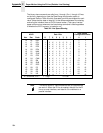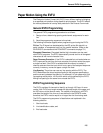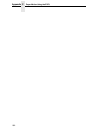
286
Appendix C Paper Motion Using the EVFU
Start Load Code - 1E or 6E Hex
The Start Load code clears and initializes the EVFU memory for channel
assignment storage. Refer to Table 25 or Table 26 for the appropriate start
load code.
Channel Assignment
The EVFU memory has the capacity for 92-line forms. The first line
identification code (channel code) in the EVFU load data defines the first line
on the form; the second line identification code defines the second line on the
form, etc. Each line must have a line identification code.
A single channel code is used repeatedly throughout a form to reserve blank
lines between defined channel codes and to maintain the correct forms
length. These “filler” channels can be any channel number except channel
code 1 (which is reserved for the top-of-form) and channel code 12 (which is
reserved as the vertical tab channel). In the EVFU example which begins on
page 289, filler channels are represented by a hex 11 code. Calls are rarely
made to filler channels because they do not specify a unique print position on
the form.
Channel 1 — The top-of-form code, reserved as the first line on the form. The
operating program sends the channel 1 code to advance to the top of the next
form. After the memory is loaded, a Form Feed code (FF, 0C hex) moves the
paper to the next channel 1 (top-of-form).
Channels 2 through 11, 13 and 14 — Used as general channel codes (also
referred to as line identification codes) or as filler channels. Each line on the
form must be identified by a channel code. When the operating program
sends the channel code, the paper advances to the line identified by the
channel code.
Channel 12 — Reserved as the vertical tab channel. The vertical tab code
(VT, 0B hex) rapidly advances the print position to the next line identified by
the channel 12 code. If channel 12 is not loaded in the EVFU memory, a
single line feed is executed when a VT code is sent.
End Load - 1F or 6F Hex
The end load code terminates the channel storage and saves the EVFU in
memory. Refer to Table 25 or Table 26 for the appropriate end load code.
Channel codes in excess of 192 channels received prior to the end load code
cause an EXECUTE EVFU load error.
Using the EVFU
Sending the appropriate EVFU channel code to the printer causes any data in
the buffer to print and slew the paper to the next line on the form having the
specified channel number assigned in EVFU memory.
To recognize a data byte as an EVFU instruction, one of the following sets of
criteria must be met:
1. The PI line must be enabled and set high;
2. Bits 7 and 6 can be set to 1 or 0; and


















